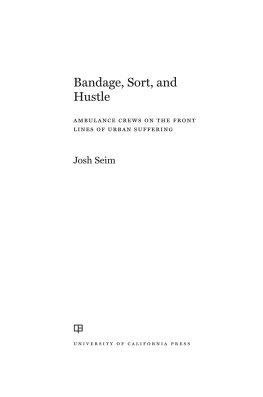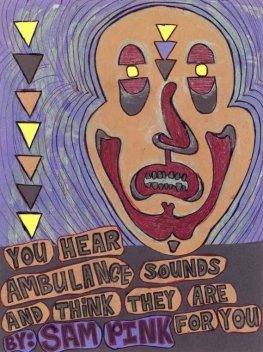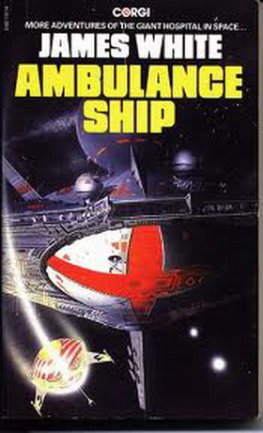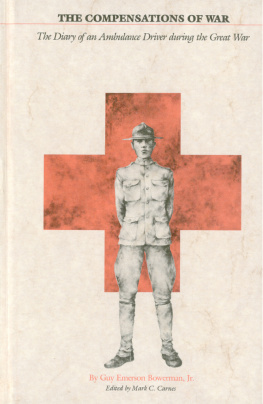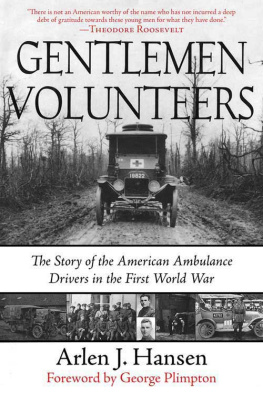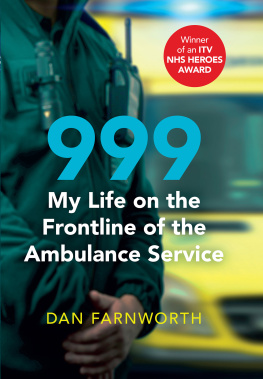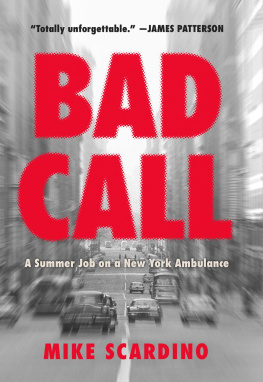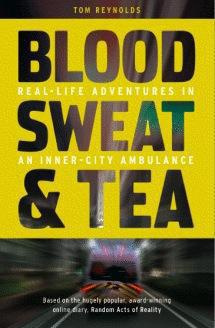Preface
Thats a picture of me driving an ambulance (figure 1). I was somewhere in the dense flatlands of a place in California I call Agonia County. At the time, I was working as one of the nations many emergency medical technicians (EMTs). My paramedic partner took this photo one hot afternoon in 2016, while we were between 911 calls.
Figure 1. At work. Note: Authors photo.
In many ways, the long and winding path that led to this photograph began five years earlier in Oregon. I was in Portland, meeting with James, who, like me, is a white male. Unlike me, though, James has spent much of his adult life in and out of squad cars, courtrooms, probation meetings, jails, prisons, and parole offices. I first met him inside a prison while I was conducting a different study. However, on this particular occasion, we met on the streets, just a few blocks from the transitional housing facility that he moved into after his recent release from prison. James told me that he hated his current living situation. He said residents were frequently stealing from one another, people were often fighting, and the living conditions constantly tempted him with the narcotics he was once addicted to.
Providing me with further evidence of this facilitys horrors, James said the ambulance was always there. He told me that ambulance crews were rushing in and out of the building at least twice a week, responding to assaults and other crises. James also mentioned that an ambulance crew had recently discovered a parolees corpse in the building. Rumor suggested it was a heroin overdose. For James, the ambulances frequent presence seemed to offer some proof that mayhem defined his living conditions.
After this conversation, I started to notice ambulances a lot more. Not only did they stick out in traffic, they also stuck out in a number of books I was reading. Written in as a background prop and with its workers cast as extras in someone elses drama, the ambulance appears in some of sociologys most influential ethnographies. Careful readers can find it in Elijah Andersons Code of the Street, Mitchell Duneiers Sidewalk, and Martn Snchez-Jankowskis Cracks in the Pavement. Not unlike James, most of these sociologists seemed to mention the ambulance simply to highlight some disorder or death in their respective field sites.
Suddenly a bit more curious about ambulances, I turned to the scholars who honed their focus on this institution. I found a number of ethnographers who had entered the ambulance to reveal its unique work culture and organizational dynamics. But these studies offered minimal insight into the way ambulance crews were handling such people on the ground. I didnt see these ethnographic and statistical accounts of the ambulance as insignificant. They just didnt really help me understand the role that this institution was playing among those who suffer most in the American city.
Fast-forward four years past my conversation with James. I was shadowing ambulance crews at a firm I call Medical Response and Transport (MRT) and collecting data for the book at hand. MRT is a for-profit 911 ambulance provider that holds contracts throughout the nation. I embedded myself within its operations in Agonia County. There, management generously allowed me to ride along in ambulances and take notes. They even permitted me to observe some managerial activities to get a birds-eye view of the organization. And, as an added bonus to this rare entry, I was able to secure over one hundred thousand deidentified medical records completed by MRT crews.
My ride-along observations brought me seemingly everywhere, from multistoried mansions perched atop steep hills to homeless encampments planted beneath highway overpasses. It nonetheless became very obvious to me after just a few days in the field that, while the ambulance can pop up just about anywhere, its usually pulled toward impoverished and otherwise disadvantaged territories. This wasnt surprising given my conversation with James and the brief, yet frequent, appearances that ambulance workers were making in urban ethnographies.
What was surprising was the variety of problems that ambulance crews were responding to. As you might imagine, the paramedics and EMTs I shadowed were definitely rushing severely sick and broken bodies to the hospital, and they were disproportionately collecting these patients from poor and nonwhite neighborhoods. However, such real emergencies ultimately accounted for a minority of the 911 calls I encountered. Ambulance crews were more commonly mitigating less urgent symptoms of the chronically ill, connecting drugless patients to prescription-writing physicians, and scooping drunk people off the sidewalk.
This book started to come into focus. I was going to break from the popular but limited understanding of the ambulance as an institution for saving and transporting the critically ill and injured. The point was not to forgo this framing entirely, but instead to think of the broader role that the ambulance is also playing in the American city. I started to consider how paramedic and EMT labor contributed to what sociologists were more or less synonymously calling a regulation, management, or governance of those populations that suffer most in the economically and racially polarized metropolis.
This labor-centric analysis proved fruitful for three reasons. First, in carefully documenting what paramedic and EMT work involved, I was able to unpack social relations inside the ambulance. Beyond underlining the fact that its heavily the poor, the nonwhite, and otherwise vulnerable populations that ambulance crews are working on, an analysis of the ambulance as a worksite clarified a general outcome of ambulance labor. I started to more clearly see paramedicine as an institution that offers rapid but generally superficial and very specific aid to suffering bodies. Second, this focus on labor also helped me locate the ambulance between two other institutions that tend to handle poorer and darker-skinned bodies in urban America: the hospital emergency department and the police squad car. I quickly noted how crews regularly shared the subjects of their labor with other frontline workers like nurses and cops. These cross-institutional interactions between workers structured not only life inside the ambulance but also the manner in which people were distributed across institutions. Third, my labor-centric analysis inspired me to consider how the ambulance is situated underneath a series of political and economic forces that control and coordinate crew labor. I learned that said forces help set the possibilities for the street-level relations between crews and their patients on the one hand and crews and other frontline workers on the other. I saw how MRTs pursuit of profit rests on the efficiency and flexibility of crew labor. This helped explain why the people who most rely on ambulance services regularly encounter exhausted and frustrated providers.

